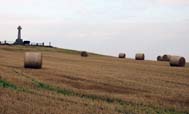Winchester Guildhall stands on part of the site of an estate granted by Alfred the Great to his wife Ealswith probably as a coronation gift in 871 AD. After his death she retired there and founded a nunnery known as Nunnaminster. Known in the later medieval ages as St Mary’s Abbey, it was one of the foremost nunneries in England. In 1539 Henry VIII dissolved the abbey and the site passed to the crown. The land came into the City’s hands to help cover its costs for hosting the wedding of Mary Tudor and Philip of Spain in Winchester Cathedral in 1554.
Old Guildhall
Winchester’s earliest guildhall was located next to the Butter Cross in a small chamber above the passageway leading from the High Street to the cathedral. In 1712 the guildhall occupied the upper chamber of the Old Market House on the High Street, while the ground floor served as a covered market. This remained the site of the guildhall until late Victorian period and the building is now occupied by Lloyds Bank. The expansion of civic responsibilities following the Local Reform Act of 1835 markedly changed the role of guildhalls and Winchester needed a newer and larger building.
The New Guildhall
The Hastings architectural firm Jeffrey and Skiller submitted a design in the Gothic revival style and on 22nd December 1871 Viscount Eversley laid the foundation stone. Nearly a year and a half later in May 1873 the new Guildhall was opened by Lord Selborne. The Guildhall was part of a larger complex, housing the law courts, police station and fire brigade but the greater part was given over to civic roles. Events for large public audiences occurred on the Broadway where the Guildhall grand façade formed a backdrop to the podium on the staircase. These included the victory celebrations following World War I and royal visit of George VI and Queen Elizabeth on the 17th May 1946.
For a building of Gothic revival design, the Guildhall façade is relatively uncluttered. Its decoration includes four statues of kings and bishops with Winchester connections. Placed in the arches above the principle windows are sculpted panels showing events reflecting the ancient dignity of the mayor and major events in the city’s history. In pride of place is the central panel below the clock tower that shows the mythical 1st mayor of Winchester Florence de Lunne receiving the city’s charter from King Henry II.
These interesting instruments are inset into the guildhall wall. So far I have been unable to find out their history…












Placed there in 1954?
As I said, I haven’t been able to find out the history of the instruments.
Veri interesting, and a lovely building.
It is an impressive building, it is situated quite near the statue of Alfred.
That new Guildhall is spectacular! It always amazes me what talent and craftsmanship they put into their work then,when we tend to look at the people as less sophisticated and skilled than we are today.
Yet, I am sure, like thatching, we have lost a lot of those art forms!
I think both the old and new guildhalls are spectacular. And yes the skills of the people who built them have been overlooked…
Very impressive. I remember walking here and liking the beauty of this all. Love the barometer and clock in the wall. I have been in Greenwich and stood with each leg in teh different time zones…
I love your photography.
You should go back and stay a few days, there is so much to see
Thank you for your kind words about my photography.
Lovely clock
Impressive isn’t it?
A very grand building. I’m trying to compare it with other similar looking architectural structures around the country but they don’t even come close to warrant a mention.
It is impressive and the tower dominates the skyline in that area.